Mercury’s Topography from the Second Flyby
Caption:
This figure shows about a 1,600 kilometer-long (1,000 mile-long) section of the MLA profile from MESSENGER's second Mercury flyby superimposed on a portion of the NAC approach mosaic from the mission's first Mercury encounter (see
PIA10605
). The blue line indicates the spacecraft ground track, and the yellow dots show the altimetry data points; the blue arrow shows the spacecraft's direction of travel. This hemisphere has about 70% of the range in topography sampled by MLA during the first Mercury flyby (see
PIA10394
) and so this part of the equatorial hemisphere is smoother than that sampled last January. Near longitude -97° (263°E) there is a wrinkle ridge nearly 1 kilometer high (yellow arrow and white box containing a magnified view) that indicates horizontal shortening of the crust, possibly the result of global contraction associated with the cooling of the interior. In the longitude range of -115° to -120° (245°E to 240°E), the instrument sampled several craters of different depths with tilted floors (tilts of -0.5° to -0.2°; example indicated with a white arrow) that may have been the result of deformational processes.
Date Acquired:
January 14 and October 6, 2008
Instrument:
Mercury Laser Altimeter (MLA), Narrow Angle Camera (NAC)
Scale:
The MLA track shown is about 1,600 kilometers (1,000 miles) long
Background Info:
These images are from MESSENGER, a NASA Discovery mission to conduct the first orbital study of the innermost planet, Mercury. For information regarding the use of images, see the MESSENGER
image use policy
.
Cataloging Keywords:
| Name |
Value |
Additional Values |
| Target |
Mercury |
|
| System |
|
|
| Target Type |
Planet |
|
| Mission |
MESSENGER |
|
| Instrument Host |
MESSENGER |
|
| Host Type |
Orbiter |
|
| Instrument |
Mercury Dual Imaging System (MDIS) |
Mercury Laser Altimeter (MLA) |
| Detector |
Narrow Angle Camera (NAC) |
|
| Extra Keywords |
Color, Crater |
| Acquisition Date |
|
| Release Date |
2008-10-29 |
| Date in Caption |
2008-10-06 |
|
| Image Credit |
NASA/Johns Hopkins University Applied Physics Laboratory/Carnegie Institution of Washington |
| Source |
photojournal.jpl.nasa.gov/catalog/PIA11405 |
| Identifier |
PIA11405 |

 Planetary Data System
Planetary Data System
